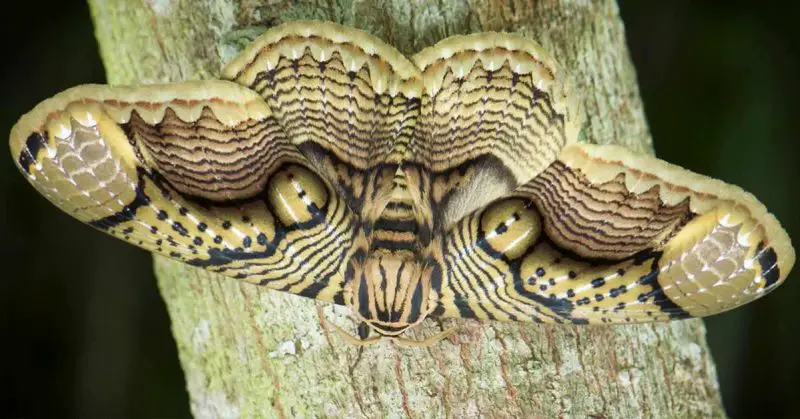Although they are from the same family as butterflies, moths are pesky and annoying insects that are certainly not as cute or light on their wings as their larger counterparts. They get in your face, all over your lights, and are often too tiny to be admired.
Well, if there’s anything special about them, when they are not buzzing about in the air, it’s the incredible patterns on their wings. There are over 160,000 species of moths in the world, many of which are yet to be identified. The patterns and colors on their wings are formed by thousands of tiny scales, overlapping like tiles on a roof. [1] When they lie still long enough to be observed, especially among the larger species, you’d often be blown away at how artistic Mother Nature truly is. She’s unrivaled, and thanks to wildlife photographers, we get to see all her creative pieces and designs, one species at a time.
Tiger-eye motif
The Brahmaea hearseyi is one such species of moths that got the best of Mother Nature’s wing designs. Also known as the tiger-eye moth, these moths come from the Brahmin family and are one of its largest species. They are particularly identified by the well-developed eyespots on their front wings and a series of black-brown stripes, often giving the striking impression of a tiger’s eye. The species are found in many places such around Asia such as Northeastern Himalaya, Burma, Western China, Sundaland, and the Philippines.
The moths are diurnal and can only be active during the day. At night, they spread out their large wings (which often have a span of 160–200mm) on the barks of trees and on rocks to rest. They are so inactive at night that when they are disturbed, they cannot fly away to safety. They only shake vigorously to ward off the predator but would remain in their spots. They are found mostly in tropical and temperate forests.
The incredible footage above was captured by wildlife photographer, David Weiller, who visited Borneo in Malaysia for an expedition. Speaking to Bored Panda, Weiller explained that the moth was just recently hatched when he came across it. [2]
“This was a lucky find as it was attracted at night to the light of my bungalow in the rainforest. When I saw it, freshly hatched and with its striking patterns, I was so surprised. After observing it fly around the light for a while, it settled for the night on a nearby tree trunk,” Weiller said.
Wallichii and Hearseyi
This moth is from the Brahmaea genus where there are 12 other unique species known for their large wings with unique black and brown patterns. The Brahmaea wallichii, also known as the owl moth, is often mistaken for the tiger-eye hearseyi. The two species have well-developed eye patterns on their front wings, although the wallichii is often smaller in size, has a duller brown appearance, and its eyespots look more like an owl’s than a tiger’s.
Describing the process of taking the video, Weiller said, “Some shots need maybe one day or one week to get, this was simple shot, moths are relatively easy to take pictures of in the cold hours of the early morning as they are not yet warm enough to fly away and stay relatively still. The next morning, at dawn, it was still sitting quietly on the same spot. I set up my tripod, camera, and macro lens, and started to take a few pictures and videos of it slowly getting warm by flapping its wings. A few minutes later, the sun came up and it flew away toward the blue sky.“
These insects are truly incredible, and their scary tiger wings provide beautiful camouflage and protection. Amazing!
References
- ” Why do butterflies and moths have such detailed wings?” MNN. Anna Norris. November 11, 2014.
- “Wildlife Photographer Shares Mesmerizing Footage Of A Giant Brahmin Moth With Tiger Eye Wing Pattern.” Bored Panda. Andželika Jasevičiūtė. May 11, 2020
- “Brahmaea wallichii.” Australian Butterflies. September 27, 2016

